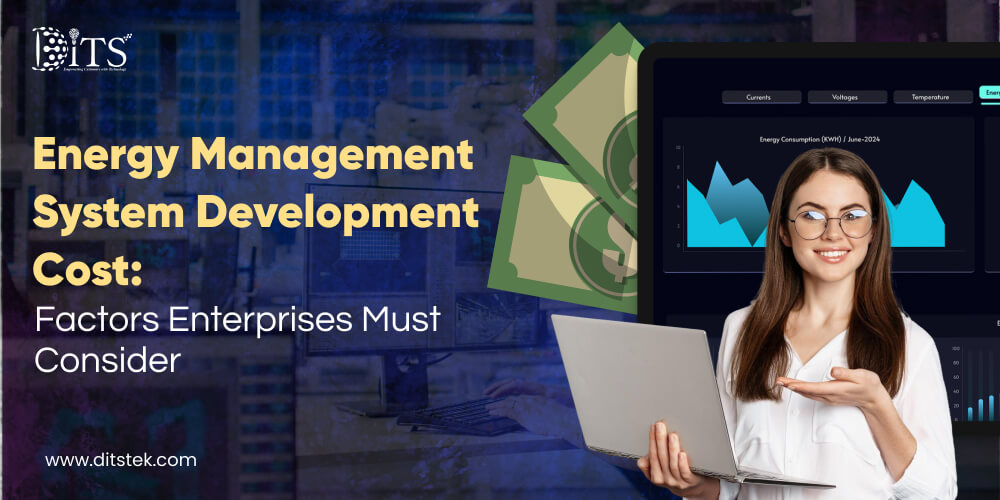Energy Management System Development Cost: Factors Enterprises Must Consider
Ditstek Blogs
For most enterprises today, managing energy isn't just about saving money; it's about staying resilient in a market where costs keep climbing and sustainability targets are tightening.
Manufacturers, logistics providers, and utilities are being asked to do more with less, without sacrificing performance or compliance.
We're finding that energy management software can change all of that. It helps organizations see specifically where and how energy is used, identify waste, and offer opportunities to maximize operations while saving energy in real time. Over time, this singular investment can change the way a company plans, operates, and scales, turning energy data into an actual business asset.
Let's be honest, however; cost is always the follow-up question. The cost of the energy management system is likely to vary widely based on complexity, integrations, and the scale of your operations. Therefore, before jumping into energy management system cost, it is helpful to understand what drives that cost and to plan wisely to maximize value for every dollar spent.
What an Energy Management System Does
In a large organization, energy flows through hundreds of systems, from production lines to HVAC units to lighting networks to logistics hubs. Monitoring these systems manually would be difficult, if not impossible. An EMS automates real-time monitoring, collects data, analyzes it, and provides actionable insights. The outcome is less waste, more accurate forecasting, and stable operational costs.
For example, a manufacturing plant may utilize an EMS to monitor how its machines are performing and identify spikes in energy use during particular shifts. A logistics company may link the EMS to its transport routes to analyze fuel consumption along those routes and minimize idle time. It is the difference between responding to the energy bills and managing your energy.
Newer or modern systems go further than this, and many now rely on the Internet of Things in the energy sector, links to sensors, smart meters, and connected devices that are much more capable of collecting high-frequency data. This not only allows a business to track its usage but also to predict demand patterns and respond accordingly. Envision air conditioning systems that operate automatically based on occupancy or a piece of machinery that powers down during off-peak periods without operator input.
Ready to Plan Your EMS Budget?
Compare cost drivers and build a realistic development plan that aligns with your business and scalability goals.
Key Factors Affecting the Cost of EMS Development
When organizations begin budgeting for an Energy Management System, it soon becomes apparent that no two systems cost the same. The final price depends on dozens of moving parts, including your industry, existing infrastructure, data complexity, and the level of automation you want. Let's unravel the cost drivers of your energy management system, layer by layer.
Project Scope and Functional Complexity
The broader the scope of your system, the more you will spend. A small manufacturing facility may only require monitoring and reporting, while a global enterprise will likely address predictive analytics, automated alerts, and energy management across multiple locations. Every module you add; performance dashboards, optimization engines; is another layer of design, development, and testing.
Hardware and IoT Sensor Integration
Here is where it can get technical. Building an IoT-based energy monitoring system involves integrating sufficient sensors, gateways, and meters to capture live data across industrial settings. These devices need to be rugged and maintain connectivity. Consequently, hardware selection, installation, and calibration can be a significant portion of your project's overall cost.
Data Management and Cloud Infrastructure
Data forms the foundation of any Energy Management System, and its storage and management affect everything – speed, scalability, and security. Some organizations prefer the flexibility of cloud hosting, while others prefer on-premises servers for greater control. Regardless of how you do it, the infrastructure has to accommodate real-time data streams and complex analytics without downtime.
UI/UX Design and System Usability
An Energy Management System is only useful if people use it. Designing dashboards that are intuitive, visual, and customizable for roles such as engineers, plant heads, and CFOs takes planning. Usability testing and accessibility design ensure that your system does not deluge users with data but provides clear guidance for decision-making.
Integration with Existing Enterprise Systems
Most organizations already have investments in their ERPs, CRMs, process automation applications, and other systems and processes. If you integrate your EMS with these existing systems, you can easily flow data between the two and reduce the risk of human and manual errors. The downside of integrating data from one system to another is that it will take more development hours to build secure APIs or other middleware to support it. The deeper you go with integration, naturally, the development time and cost increase.
Security, Compliance, and Data Privacy
When it comes to industries managing sensitive data, such as utilities, mining, or manufacturing, a security system is not at all negotiable, which imposes greater technical overhead on top of meeting standards like ISO 50001 compliance and GDPR compliance at the same time, while giving your business protection from incidents of downtime, the probability of breaches, and risk of compliance penalties.
Scalability and Future Upgrades
Your EMS should be designed to grow as your business grows. There should be a degree of scalability that allows adding more plants, users, and data points without having to start over. The fundamental architecture, including a modular systems approach and flexible APIs, will enable that capability. This obviously creates higher initial costs, but the risk of higher costs later from redevelopment is far greater.
Estimated Cost Breakdown for Energy Management Software Development
| Development Stage | Key Activities | Estimated Cost Range | Enterprise Impact |
| Discovery & Requirement Analysis | Stakeholder interviews, process mapping, feasibility studies | $5,000 – $15,000 | Defines scope and business goals before coding. |
| System Architecture & UI/UX Design | Backend/frontend coding, analytics modules | $40,000 – $80,000 | Builds intuitive dashboards that improve user adoption. |
| Core Software Development | Backend/frontend coding, analytics modules | $40,000 – $80,000 | Creates real-time dashboards and analytical models. |
| IoT Integration & Hardware Setup | Sensor calibration, data gateways, API connectivity | $15,000 – $30,000 | Enables real-time data collection and control. |
| Cloud Infrastructure & Database Development | Cloud setup, security configuration, database scaling | $10,000 – $25,000 | Provides secure, scalable performance and compliance. |
| AI & Predictive Analytics Integration | ML model training, energy forecasting, automation | $20,000 – $40,000 | Adds intelligence to forecasting and energy control. |
| Testing & Quality Assurance | Functional, load, and security testing | $8,000 – $15,000 | Ensures system reliability and high performance. |
| Deployment & Integration | CI/CD setup, ERP/MES sync, pilot rollout | $6,000 – $12,000 | Smooth system launch across departments. |
| Training & Change Management | User onboarding, documentation | $3,000 – $7,000 | Improves adoption and ROI. |
| Ongoing Support & Maintenance | Performance monitoring, patches, model updates | $1,500 – $4,000/month | Keeps the EMS optimized and secure. |
Total Estimated Investment: Typically between $80,000 and $200,000 depending on project scope and integrations.
Hidden and Long-Term Cost Components
Most enterprises focus on upfront development costs, but the truth is, that’s just part of the story. The long-term expenses often sneak up later — and if not planned for early, they can quietly chip away at your ROI.
Continuous Maintenance and Updates
As new standards, APIs, and compliance norms emerge, your EMS will need upgrades and patches to stay efficient and secure.
Cloud Hosting and Storage
Cloud-based EMS requires monthly storage, hosting, and bandwidth costs. Choosing scalable plans ensures flexibility as your energy data grows.
AI Model Training and Optimization
When predictive analytics are part of the system, the AI must be retrained regularly. At DITS, our AI software development team handles this continuously, ensuring accuracy and adaptive forecasting.
Integration Maintenance
Whenever connected systems like ERP or SCADA update, compatibility checks or integration tweaks may be required.
Training and Change Management
With new teams and evolving workflows, periodic training ensures smooth system adoption.
Scalability
Future expansion may require more nodes, databases, or regional support — planned scalability prevents large rework costs later.
Want a Custom EMS Cost Analysis?
Receive a detailed breakdown of development stages, integrations, and long-term savings tailored to your enterprise needs.
Approximate EMS Development Cost Ranges
For a basic EMS, the investment usually falls between $25,000 and $50,000. It includes energy tracking and simple reporting for smaller setups.
A mid-level EMS with advanced analytics and limited IoT connectivity may cost around $60,000 to $120,000, ideal for mid-sized industrial operations.
An enterprise-grade solution with deep automation, predictive analytics, and multi-site integration can range from $150,000 to $250,000 or more.
Your energy management system cost is an investment. Most companies see returns in 12–18 months through energy savings, reduced downtime, and improved operational efficiency.
At DITS, we embed AI across our process; automating code reviews, maintaining quality, and ensuring each project performs flawlessly over time.
Cost Optimization Strategies for Enterprises
Start with a Clear Roadmap
Define your energy goals before development starts. Clarity reduces wasted effort and keeps costs focused on meaningful outcomes.
Build in Phases
Roll out in stages, core modules first, analytics and automation later. This keeps budgets controlled while allowing teams to adapt.
Choose Scalable Architecture
Invest slightly more upfront to save big later. Scalable systems grow effortlessly with your operations.
Opt for Cloud or Hybrid Setup
Cloud platforms cut infrastructure expenses and simplify scaling. Hybrid models offer both control and flexibility.
Partner with Experts
A custom application development company brings deep technical and industry knowledge. At DITS, we leverage AI-driven development and automated testing to shorten delivery cycles and lower costs.
Reuse and Integrate
Utilize existing digital tools and infrastructure. Integration avoids duplication, lowers maintenance, and boosts efficiency.
Why Choose DITS for Energy Management System Development
Building a high-performing EMS takes experience, precision, and technical depth. That’s where DITS stands apart.
With nearly a decade of experience, we’ve delivered results for global clients in manufacturing, logistics, utilities, and mining. Every solution we build is custom-made, fitting seamlessly into existing ecosystems.
At DITS, we use AI at every stage - from code quality checks to user experience personalization — ensuring systems that perform smarter and adapt faster. Our 97% client retention rate speaks for itself, driven by transparent communication and consistent support.
We’ve helped enterprises modernize with intelligent solutions, whether through Internet of Things-enabled energy sector integrations or enhanced transport and logistics management workflows. And we don’t stop at deployment; our ongoing optimization ensures systems continue to deliver measurable results year after year.
Want Expert Guidance Before You Build?
Collaborate with a team that’s engineered enterprise-grade EMS solutions globally. Get clarity before development begins.
Conclusion
A sophisticated energy management system provides an organization with visibility, control, and intelligence to drive ongoing savings and experience-based decision-making.
The energy management system you select will change the trajectory of your business, it transforms consumption data into actionable intelligence. While the costs of these systems vary, the benefits of reduced waste, improved efficiency, and a more sustainable future are evident.
At DITS, we combine domain expertise, AI-enabled innovation, and years of shared industry experience to design scalable, future-ready systems. When you partner with DITS, you invest not just in technology, but also in sustainable business growth.
FAQs
1. What is the typical timeline for developing an enterprise-grade Energy Management System?
Simple EMS development can take three to four months, and an AI-based multi-site platform can take anywhere from six to ten months, depending on the level of sophistication.
2. How can my organization calculate ROI from an EMS?
Return on investment can be determined by reduced energy usage, improved forecasting, and lower maintenance expenses. Most companies see a return on investment within twelve to eighteen months.
3. Which industries benefit most from Energy Management Systems?
The most impact is seen in manufacturing, mining, logistics, and utilities. That said, virtually any business that uses a lot of energy will benefit from the best energy management software.
4. Can an EMS integrate with ERP or SCADA systems?
Yes, with advances in software, modern systems integrate seamlessly with existing tools in enterprise solutions to provide unified visibility and decision-making.
5. Why choose a custom EMS over off-the-shelf software?
A custom system puts you in control and aligns with your processes, compliance, and scalability, while a generic piece of software has its limitations.
6. How does DITS ensure long-term performance of its systems?
Using AI-driven updates, proactive monitoring, and ongoing maintenance guarantees scalability, reliability, and sustained performance.

Dinesh Thakur
21+ years of IT software development experience in different domains like Business Automation, Healthcare, Retail, Workflow automation, Transportation and logistics, Compliance, Risk Mitigation, POS, etc. Hands-on experience in dealing with overseas clients and providing them with an apt solution to their business needs.
Recent Posts
Get in touch








.jpg)

